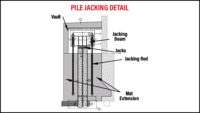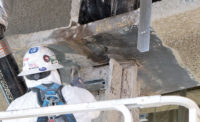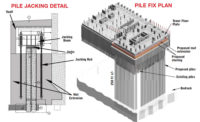Ironworkers Install Girder Splints at Troubled San Francisco Transit Hub

Crews use teal-colored C-clamp to position a new lower splint plate under the girder’s bottom flange.
PHOTO COURTESY OF TJPA

Through-bolted upper and lower splint plates sandwich each girder’s bottom flange.
PHOTO COURTESY OF TJPA


Field work to fix two fractured girders is underway at the troubled Salesforce Transit Center in San Francisco. The Transbay Joint Powers Authority expects the work to be done by early June, but TJPA has yet to announce a reopening date for the 1.2-million-sq-ft hub, shuttered since late September after the discovery of fractures in the bottom flanges of the two bridge-like girders that span 87 ft over Fremont Street. The depot had been operating for six weeks.
In another development, Pelli Clark Pelli Architects, the architect for the hub, confirms the public owner, TJPA, will pay PCPA some $5 million—$2 million for building-wide reviews to confirm the structure’s integrity and $3 million for work unrelated to the girder failures. It is the first payment since the fractures came to light.
The impending fee thaw was first reported in the San Francisco Examiner, in an April 9 article. Though TJPA has not confirmed the report, Randolph J. Volenec, a PCPA associate principal, says the “San Francisco Examiner article is accurate, including the findings that fabrication issues, and not design, were behind the failure of the Fremont Street girders.”
The hub’s contractors dispute the finding (ENR 4/15 p. 8). Having stated publicly that the contractor is at fault, TJPA says it is still conducting “a thorough review of the issues” and that a final report will lead to more discussions of the issue.
The Webcor/Obayashi Joint Venture built the hub. Skanska USA Civil is the steel subcontractor. Herrick Corp. supplied the Fremont girders and a twin pair that span First Street. Those two did not fracture but are still getting retrofits.
The fix and retrofit designs by hub engineer-of-record Thornton Tomasetti are the same. The design calls for a 28-ft-long steel double-splint for each bottom flange, through-bolted to the top and bottom of the flange. Each 2-in.-thick, 70-ksi splint, which is a fracture critical tension component, consists of two 14-ft-long plates on each side of the web. The plates sandwich the flange at its midspan.
For each girder, each matched-pair double splint has a total of 112 bolts, 56 on each side of the apex of the tapered girder. There are 224 bolts per girder. Each is 10 in. long.
Splint plates are shipped from Herrick’s shop to the field with shop-drilled 1¼-in.-dia bolt holes and a blasted finish.
For each girder, ironworkers first fit and align the lower splint under the bottom flange using a Herrick-designed forklift frame and bridge clamps. Crews punch holes in the flange for both alignment holes for the upper splint and final holes in the permanent condition.
Workers then remove the lower flange plates and drill, overhead, 1¼-in.-dia bolt holes through the 4-in.-thick bottom flange. After removing drilling debris and cleaning, workers fit and align the upper new plate to the flange. Crews then punch all remaining hole locations, remove the upper plate and drill 1¼-in.-dia holes through the existing flange.
After debris removal and cleaning, workers prepare the girder surface for abrasive blasting. Then, they set up a sandblasting clean room and blast appropriate surfaces to the specified finish. After cleaning, crews fit and align new top and bottom plates using 11⁄8-in.-dia slip-critical bolts. Then, crews tension the bolts.
The final steps are to install stiffener plates that replace the stiffener that was cut out to allow access for the repair work and to insert fill plates on Fremont to replace the fractured areas.






